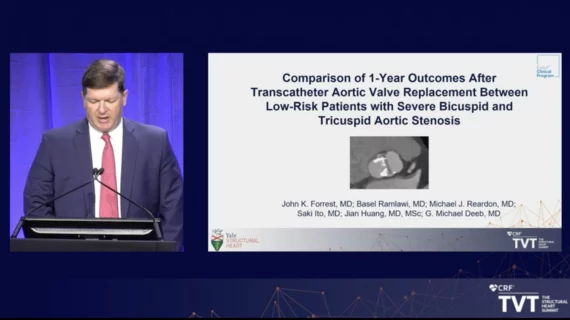TAVR outcomes similar after 1 year in low-risk bicuspid, tricuspid aortic stenosis patients
Transcatheter aortic valve replacement (TAVR) outcomes after one year are comparable between low-risk patients with bicuspid and tricuspid aortic valves, according to new data presented at TVT 2021 in Miami.
The findings were shared—both in person and virtually—by lead author John Forrest, MD, a cardiologist at Yale School of Medicine. Forrest’s team had previously shared 30-day outcomes comparing TAVR outcomes among patients with bicuspid and tricuspid aortic valves—this analysis represented an update looking at a full year of data.
Forrest started by noting how great it felt to be presenting data in a room full of colleagues again after attending so many recent conferences at home due to COVID-19.
“It is certainly wonderful to be back in person,” he said with a smile.
Forrest than moved on to his presentation, summarizing the importance of his team’s data.
“As we all know, patients with bicuspid aortic valve anatomy have been excluded from all of the major randomized TAVR trials, including the recent low-risk studies,” he said. “With that being said, bicuspid valve anatomy is present in up to 50% of low-risk patients referred for aortic valve replacement.”
The group’s analysis, sponsored by Medtronic, examined 150 TAVR patients with bicuspid heart valves treated at one of 25 facilities in the United States. CT findings were used to determine each patient’s bicuspid type. Outcomes were then compared with TAVR patients with tricuspid aortic valves. All patients from both groups received either Medtronic’s Evolut R or PRO valve.
Overall, Forrest reported, “the presence of a bicuspid valve did not result in differences in major clinical outcomes after one year.” While the one-year rate of death or disabling stroke was 1.4% in patients with bicuspid valves, it was 2.8% in patients with tricuspid valves.
The TAVR patients with bicuspid valves did undergo pre-implant valvuloplasty more frequently, he added, but this was “encouraged” by clinicians. There were no differences in post-dilation or stroke.
Forrest concluded by praising the work of heart teams throughout the country, noting that they have been doing a strong job in recent years when it comes to carefully selecting the right treatment option for each patient.
More information on TVT 2021, including details on how to access full presentations, is available here.

